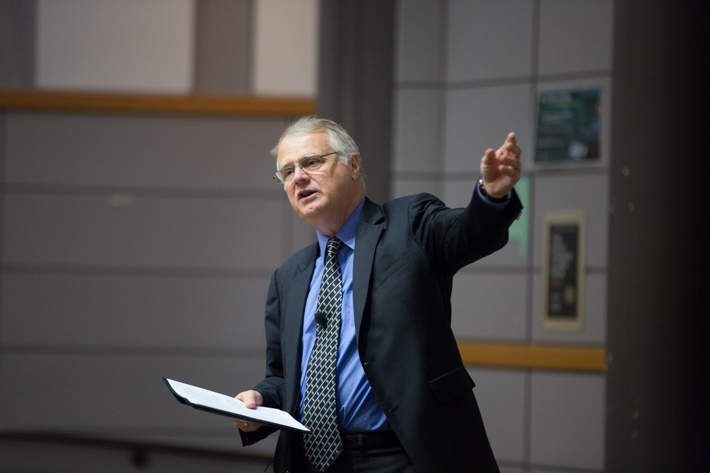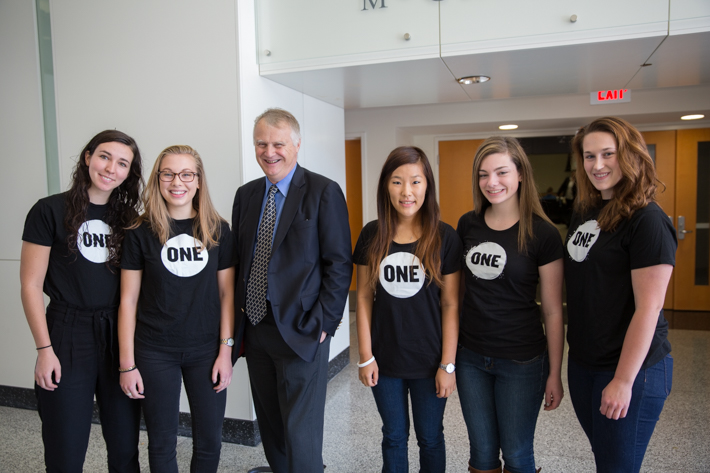While many George Washington University freshmen are setting up midterm study groups, School of Business freshmen have added a larger task to their to-do lists—ending extreme poverty.
That problem and gender inequality, universal primary education and sustainability are just a few of the world issues that 200 incoming GWSB freshmen tackle during the Age of Globalization, a course offered for the first time this semester.
Scheherazade Rehman, the Steve Ross professorial fellow of international finance, GWSB professor of international business and finance and Elliott School of International Affairs professor of international affairs, developed the mandatory interdisciplinary class to challenge students to create a campaign that raises awareness of the United Nation’s 2015 Millennium Development goals and encourages people to act.
“There is no question that the planet’s natural resources and economic resources are at a tipping point,” Dr. Rehman said. “We want students to ask themselves, ‘What is the one thing that makes me so angry that it will drive me to effect change?’” she said.
In 2013, the University Strategic Planning Steering Committee led by Provost Steven Lerman forged the idea for the course. Dr. Rehman, who was a member of the committee, is team teaching the course with GWSB professors Noel Maurer, Liesl Riddle and Nathan Jensen. The class takes a multi-lens approach to global issues, from geography to history, economics, politics and cultural context.
Dr. Rehman said that the team-taught course gives students an overview of the problems that their generation will face once they graduate—and the tools to combat them.
GWSB freshman Priyanka Walimbe was inspired to raise awareness about the lack of women representatives in Congress.
“This class is really phenomenal in that it gives us exposure to real-world, pressing issues,” Ms. Walimbe said. “This particular issue—equality for women in the political sphere—is something the entire group is passionate about. We simply cannot have a governing body that is 18 percent women, when 50 percent of the total population is female.”
On a recent Monday, the class heard from ONE President and CEO Michael Elliott that there aren’t any shortcuts for solving the world’s toughest problems.
“There is no silver bullet for eradicating income inequality and encouraging global development,” Dr. Elliott told the class of aspiring problem solvers. “You know a campaign is successful when it creates policy change with measurable outcomes.”

ONE CEO Michael Elliott said that the "can-do" attitude of Millennials will be an asset as they tackle the problems of the world.
According to Dr. Elliott, ONE creates change by combining awareness and advocacy from insiders and members.
He said that the “theory of change” is what helped the organization—most notably known for celebrity cofounder Bono—influence 75,000 people to individually petition their government representatives to support the Energize Africa Act of 2014. The bill would establish a U.S. policy to assist countries in sub-Saharan Africa in improving access to affordable energy sources.
ONE’s advocacy helped the bill earn 117 bipartisan sponsors. It passed in the House of Representatives in May.
“One thing that typifies the millennial generation is that they do something for themselves,” Dr. Elliott said. “There’s a nice junction between the needs that are out there for poverty and preventable disease and this generation’s ‘can-do, let’s do this for ourselves’ attitude.”
Students also will hear from speakers such as Shari Bryan, vice president of the National Democratic Institute, and Layli Miller-Muro, founder and executive director of the Tahirih Justice Center, an advocacy organization for victims of gender-based violence.
“Everyone in the world is concerned with the same five or six issues,” Ms. Bryan said. “They want a clean environment, a good education, safety and security, a stable economy, opportunity for jobs and health care for their families. I think it is phenomenal to teach future business leaders that global politics and shared community values affect their success in the market.”
The goal is to teach students to go beyond the bottom line because creating solutions to 21st-century global problems will require a range of perspectives and skills, Dr. Rehman said.
“The idea of cross-disciplinary work is important to the strategic plan and the course,” she said. “Imagine bringing together a dance student, a business student, an engineer and an international relations student and asking them to fix a problem— their different perspectives would help them develop a creative solution.”
Students will create a campaign video on YouTube for one of the U.N. Millennium Development goals for a final project. They will be graded based on the number of views their video receives.
A trip to the World Bank last month, which included a lecture by Angelica Silvero, head of the World Bank Speakers Bureau, was an opportunity to jumpstart their projects. Ms. Silvero encouraged students to discover how their passions align with their field of study to solve problems, Dr. Rehman said.
Angelico Silvero, head of the World Bank Speakers Bureau, encouraged students to pursue solutions to issues that they are passionate about.
“The problems of the course are the problems of the world,” Dr. Rehman said. “The World Bank bills itself as the ‘solutions bank’ and with this course we want our students to help us build a ‘solutions school’ at the university.”
The course also will include a 3-D printing demonstration on Nov. 3 led by Davide Prete, adjunct professor and sculpture coordinator in the Corcoran School of the Arts and Design. The demonstration will showcase how disruptive technology such as 3-D printing will revolutionize industries, including medicine and architecture.
“There are children with prosthetic limbs whose parents have been able to use a 3-D printer at home to make new prostheses as their child grows,” Dr. Rehman said. “It’s a much cheaper solution than a hospital visit.
“We want our students to see that there are many ways to solve a problem when the right minds come together,” she added.


